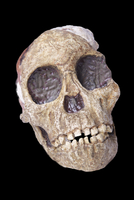Africa is the second largest continent on earth and has incredibly diverse natural landscapes. It is therefore no surprise that fossils have been discovered in all corners of the great continent and have made large contributions to Palaeontology in the process. Prehistoric wildlife from Spinosaurus to Australopithecus are a couple of examples of fossils that were discovered on European expeditions to Africa, but have had the accomplishments of the local people that were also involved, seamlessly disassociated with them. For many, these European-led explorations in the 19th and 20th centuries can’t be separated from African fossil discovery, however it is known that native people in Africa were involved in Palaeontology before any European contact.
One of the earliest known cases of fossil collecting dates back to 300,000 years. Early Homo sapiens were found to have collected fossil seashells in Morocco. The evidence for this is the fact that fossilised cuttlefish shells were found at Erfoud, far from where these fossils are native to, suggesting they were carried and deposited by people. Although they were probably used for ritual purposes and not studied or put up in a museum, this shouldn’t be ignored and should be seen as representative of early human curiosity that led to the Palaeontology we know today.

This isn’t the only significant case of early fossil collecting in Africa, as there is evidence all over the continent for instances like this. A tomb filled with prehistoric fossils was discovered in 1922, some thought to have been 2 million years old. The site, located near Qau el-Kebir, Egypt dates back to 3,300 years ago and shows more evidence of early fossil transportation, as well as using them for spiritual purposes.
A more recent discovery from an unknown person in Africa took place in the early 1820s. What is though to have been the first discovery of a fossil in the Karoo region of South Africa was by an unnamed Griqua person. They discovered a fossil of a Mesosaurus, a reptile from the Devonian period. This discovery was so significant as Mesosaurus became a crucial piece of evidence for the tectonic plates shifting theory, as specimens have been found in South America as well as the southern parts of Africa. This person, whose name was never recorded, is only mentioned in passing in a report about the finding and what it contributed to the theory, and was most likely never paid. Because of this, we will sadly never know the identity of the person that made this important discovery.
Although the previous examples happened many decades ago, there are still instances that happen in the modern day. One example of this is the discovery of “Little foot”, an important specimen of Australopithecus. Ronald J. Clarke, a Paleoanthropologist, sent two of his technical assistants, Nkwane Molefe and Stephen Motsumi to a cave in South Africa to find the skeleton, as Clarke had found bones from two feet in a box of monkey fossils at the University of Witwatersrand which were labelled to be from this location. Molefe and Motsumi found the skeleton within 2 days of searching and reported back to Clarke. The excavation carried on for 15 years after this. As this discovery occurred post-apartheid, the two men received recognition of their role and were part of the press conference to announce the finding. However, despite initial recognition whilst the story was covered by media all over South Africa, Molefe and Motsumi were never able to pursue an education or career in science, despite their significant contribution. This shows that, despite the progress in some areas, there is still a long way to go before decolonisation can benefit all areas of science.

Museums, universities and other educational institutions around the world can no longer hide the fact that, for many of them, they were founded on the basis of racism, slavery and colonisation.
Manchester Museum is committed to decolonising our collections in an attempt to showcase the stories of people that have otherwise been written out of history. It is important to give credit to those that have contributed to discovery that were ignored on the basis that they weren’t White European.
Institutions around the world should look at their colonial past in order to educate people and to help the fight against racial inequality.
You can find out more on early African Palaeontology and Decolonisation by visiting the Manchester Museum collections online or by following @IndigeniseMcr on Twitter.
You can also read literature on these matters in books such as Christa Kuljian’s “Darwin’s Hunch” and Gerhard Maier’s “African Dinosaurs unearthed: The Tendaguru expeditions”, and you can also listen to the Palaeocast episode, Decolonisation of Palaeontology, where some of the information on this blog post came from.
References
– The Conversation. 2017. It’s time to celebrate Africa’s forgotten fossil hunters. [online] Available at: <https://theconversation.com/its-time-to-celebrate-africas-forgotten-fossil-hunters-77345>.
– The Conversation. n.d. What would it mean to decolonise palaeontology? Here are some ideas. [online] Available at: <https://theconversation.com/what-would-it-mean-to-decolonise-palaeontology-here-are-some-ideas-102133>.
Filed under: Uncategorized |




Leave a comment